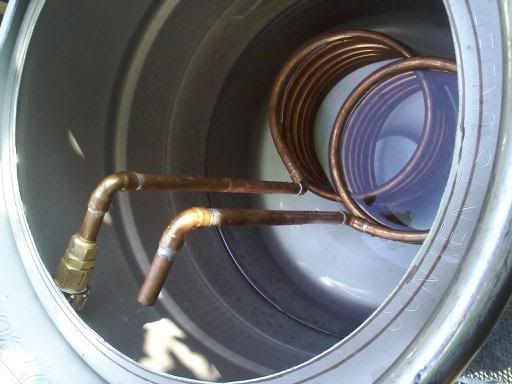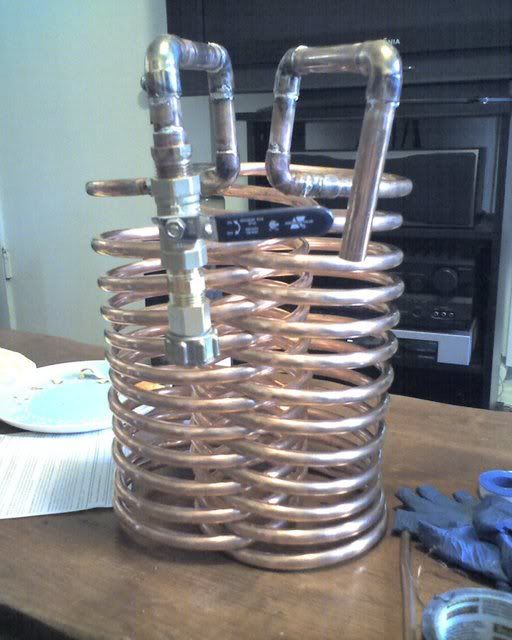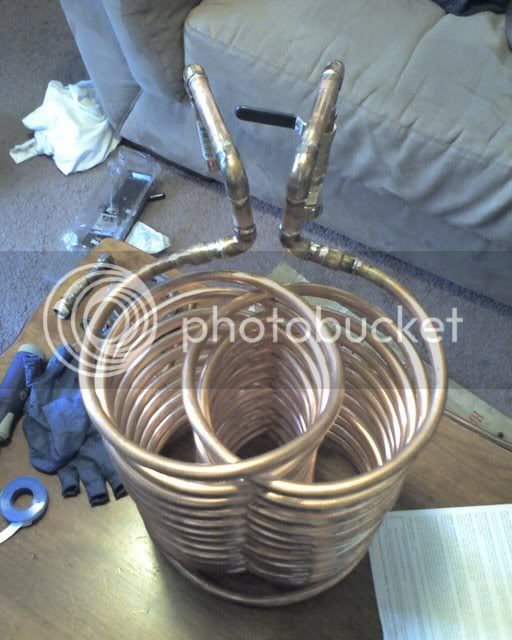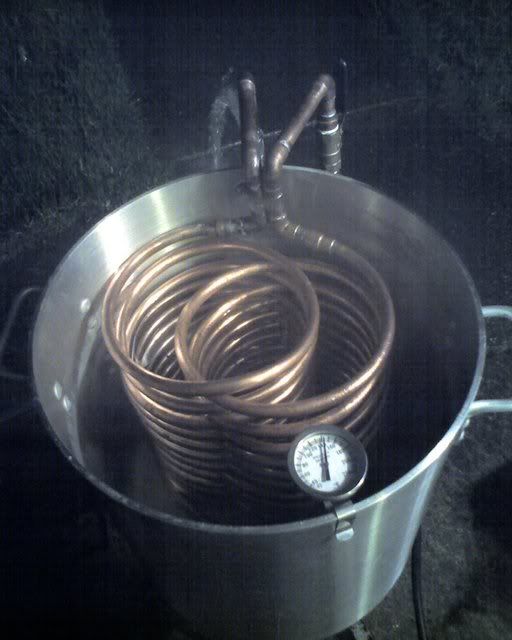Elfmaze
Well-Known Member
when i get home i'll put mine in the keggle. The lid may be a problem isf you cut the hole narrow. Keggles are all unique

I'm bumping this thread because I'm wondering if anyone has tried this with a keggle. I have purchased all the materials to build a single column IC for a keggle (I just made) but after seeing this rib-cage IC I've put the breaks on.
If you use the 2 paint cans method I think rib-cage IC going to be too wide to fit in the keggle. This would imply smaller diameter columns. I'd like to know if others have already tried??
Thanks.
THe water is heated up on its way through the first coil, and then as its racing up the second, there should be a small temperature differential in the wort.
:shrug:
If theres only a small temperature differential, that part of the chiller isn't chilling. You guys would be much better off splitting the feed and having two separate attached coils.
If theres only a small temperature differential, that part of the chiller isn't chilling. You guys would be much better off splitting the feed and having two separate attached coils.

So how are you guys bending the tubing so smoothly without kinking it? I was under the impression that it kinks pretty easily.
just take your time. and don't try to bend too tight. paint can, cornie keg, something about that size. the smaller you try to wrap it, the easier it is to kink.
So how are you guys bending the tubing so smoothly without kinking it? I was under the impression that it kinks pretty easily.






Mechanical engineer jumping in here. If the flow around the chillers is turbulent, then both chillers will be functionally identical. Shaking a chiller or stirring wort isn't exactly a difficult thing to do.The original chiller that I posted in here was 20' of 3/8" tubing and with 42* input water would chill 5 gallons to pitching temp in 9 minutes. Realistically speaking, there was 18' in contact with the wort. Thats pretty damn fast. Could it go faster? Sure it could with a better optomized design.
But again, the point that the ones that want to pick apart the design always miss is this: A dual coil design will chill faster than a single coil design. The reason why is more wort coverage/more even distribution of coils throughout the wort.
I guarantee that you can make a single coil chiller out of the same material, same length, as a dual coil design and the dual will be faster.

Mechanical engineer jumping in here. If the flow around the chillers is turbulent, then both chillers will be functionally identical. Shaking a chiller or stirring wort isn't exactly a difficult thing to do.
You appear to have misunderstood the mechanism by which forced convection cools more quickly. It has nothing to do with the difference in thermal conductivity between copper and wort and everything to do with the temperature difference between the chiller and the wort. Forcing convection means that a temperature gradient never forms, and heat transfer is based upon a step function between the free stream velocities of the coolant and the wort.I am also a mechanical engineer.
I would disagree somewhat. Yes, theoretically speaking, heat transfer over the same surface area would make both chillers chill identically given the warm parts of the batch of wort could flow over the surface of the tubing equally. In a perfect world, you are completely correct. We engineers like to think in terms of a perfect world because it makes things easier. That is where the problem lies. The thermal conductivity of water is 0.6 W/K*m versus copper thermal conductance of 401 W/K*m. A cold pocket of wort is formed around the IC coils and the wort is much worse at heat transfer than the copper. With a traditional IC, the only way to gain the benefits of the copper's superior heat transfer ability is to stir the wort vigorously. "Swirling" a traditional IC in a pot still leaves a big pocket of wort in the middle that has a difficult time contacting the copper coil.
Now, you mentioned that "shaking a chiller or stirring wort isn't exactly a difficult thing to do." If that were everyone's mentality, then there would be no autosiphons, spigots, transfer pumps, or any other brewing innovation... as an Engineer, I would think you would be the first to welcome an idea that could improve a process.
Anyway, the dual coil design essentially covers that central portion (and then some) of wort that has a hard time getting in contact with the traditional IC. On top of that, if you "swirl" the rib cage IC, the wort will be much more turbulent than swirling with a traditional IC, thus creating even more copper surface contact.
That's my two cents. Besides, the rib cage IC just looks cool. :rockin:
You appear to have misunderstood the mechanism by which forced convection cools more quickly. It has nothing to do with the difference in thermal conductivity between copper and wort and everything to do with the temperature difference between the chiller and the wort. Forcing convection means that a temperature gradient never forms, and heat transfer is based upon a step function between the free stream velocities of the coolant and the wort.
The pocket of wort in the middle has almost no angular velocity and is thus a poor approximation of forced convection. The flow across the chiller will be most turbulent farthest from the center of the kettle, where a normal IC has the most coils.

Given zero stirring, I'd say that the chiller with the furthest spread on the coils would chill most quickly. That's kind of like asking whether I'd prefer to be kicked in the shin or in the balls, though.I understand the forced convection argument. That is why I included it in my argument. I just disagree with the fact that a temperature differential in the wort "never forms" under conditions that most brewers chill. Again, I agree that if your forced convection current was sufficient enough to create a uniform temperature in the wort, then your theory would be sound.
In my mind, though, two things go against this scenario. First, many think that vigorous stirring at high wort temperatures allows for detrimental oxygenation (as opposed to beneficial aeration after cooldown) of the wort. Second, I would argue that if one did decide to stir hot wort, most people would do it with not near enough strength to create enough current to keep uniform temperature in the wort, thus, a temperature gradient DOES exist.
I think this is all a bit of a moot argument since we are arguing a dynamic situation with our best speculations. So let me ask you this, given zero stirring, which wort chiller would you say would cool the wort faster?
Note: I absolutely love debating things like this but have been told by numerous friends and associates that I come off as argumentative. Please know that I am very much enjoying our back and forth, maskednegator.


Hey any of you folks out there whirlpooling with one of these? Does it affect the formation of the trub cone?
I am going to be building my chiller soon and like the looks of this design but want to recirc/whirlpool. What is the word rib cagers? Anyone whirlpooling do you still get a cone?
 I already bought a 25' copper immersion chiller from a guy off of CL, so now I used them both. The 25'er is used as a prechiller, which I place in a 5 gallon bucket full of ice (snow) water and salt to drop the H2O temp. and the rib cage chiller goes into my 5 gallon pot to chill the wort. I used all 75', so that when I finally get my SS kegs converted and move to all grain, 10 gallon batches, I have something that will handle that capacity. I have used this system twice and was able to cool both batches from boiling to 80 degrees in under 10 minutes. It works great! Just thought I would share my experience with my chillers.
I already bought a 25' copper immersion chiller from a guy off of CL, so now I used them both. The 25'er is used as a prechiller, which I place in a 5 gallon bucket full of ice (snow) water and salt to drop the H2O temp. and the rib cage chiller goes into my 5 gallon pot to chill the wort. I used all 75', so that when I finally get my SS kegs converted and move to all grain, 10 gallon batches, I have something that will handle that capacity. I have used this system twice and was able to cool both batches from boiling to 80 degrees in under 10 minutes. It works great! Just thought I would share my experience with my chillers. 


 Cant wait to try it out on beer!
Cant wait to try it out on beer!Enter your email address to join: